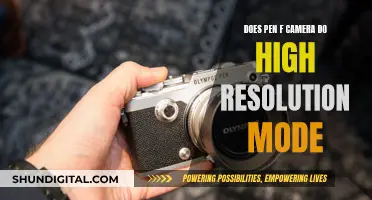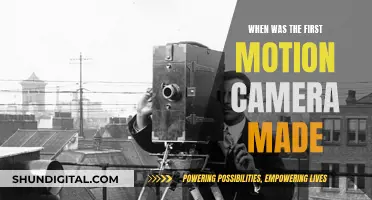
Casio is a Japanese multinational electronics manufacturing company that was founded in 1946. They are known for their calculators, mobile phones, digital cameras, electronic musical instruments, and analogue and digital watches. Casio was an early digital camera innovator, and in 1995, they released the QV-10, the first consumer-grade digital camera with an LCD screen. This camera was awarded the status of Essential Historical Material for Science and Technology by Japan's National Museum of Nature and Science. The QV-10 had a 1.8-inch colour display and cost ¥65,000 upon its release, which was a breakthrough price at the time and helped it achieve wide success.
| Characteristics | Values |
|---|---|
| First consumer LCD digital camera | QV-10 |
| Resolution | 250 kilopixels |
| Release date | 1995 |
| Price | ¥65,000 |
What You'll Learn

The QV-10 was the first consumer-grade LCD digital camera
In 1995, Casio released the QV-10, the world's first consumer-grade digital camera with an LCD screen. The QV-10 was a revolutionary product, as it allowed people to view and delete photos on the go—something that had not been possible with digital cameras up until that point.
The QV-10 was developed by a team led by Hiroyuki Suetaka and was the first camera to feature a liquid-crystal display on the back. It had a 1.8-inch colour display and a resolution of 250 kilopixels. The camera cost ¥65,000 upon its release, which was a breakthrough price at the time and helped it achieve wide success.
The QV-10 was the third Casio product to be recognised as "Essential Historical Material for Science and Technology" by Japan's National Museum of Nature and Science. This award recognises the significant contribution the QV-10 made to the rise in popularity of digital photography.
Casio was an early digital camera innovator and is known for creating features that became standard in cameras introduced years later. The company stopped selling cameras globally in 2018.
Charging Vintage 8mm Cameras: A Step-by-Step Guide
You may want to see also

Casio was an early digital camera innovator
The QV-10 was also the first consumer digital camera with a liquid-crystal display (LCD) on the back, developed by a team led by Hiroyuki Suetaka. This feature would become standard on cameras introduced in subsequent years by other manufacturers. Casio's early innovations also included the first consumer three-megapixel camera, the first true ultra-compact model, and the first digital camera to incorporate ceramic lens technology using Lumicera.
Casio continued to innovate with the release of the QV-700 in 1998, which offered pre- and post-shot buffering, allowing photographers to save a few images before or after pressing the shutter release. The company also pioneered scene modes, which it called "Best Shot" modes, with the QV-4000 in 2001, offering 100 different scene modes on an included CD-ROM.
In 2002, Casio introduced the Exilim brand of digital cameras, which included the Exilim Card series—ultra-compact models about the size of a credit card. The Exilim Card series sparked competition among camera manufacturers to make slimmer compact digital cameras, with other companies releasing their own lines of thin cameras from 2004 onwards.
Casio's other notable digital camera releases include the EX-F1, which incorporated high-speed technology capable of capturing subjects invisible to the naked eye, and the TR series, which allowed users to take "beautiful selfies" in a variety of free photography styles.
Casio stopped selling cameras in the US several years ago and ended its global camera sales in 2018, but its legacy of innovation in the field of digital photography remains.
Choosing the Right Batteries for Your Action Camera
You may want to see also

The QV-10 had a 1.8-inch colour display
The QV-10 was a groundbreaking product when it was released in 1995. It was the world's first consumer-grade digital camera to feature an LCD screen for previewing and viewing images. The 1.8-inch colour display was a significant step forward in the world of digital photography, as it allowed people to view and delete their photos on the go. This was a major improvement over the digital cameras of the 1990s, which could not match the image quality of their film-based counterparts.
The QV-10's LCD screen was a revolutionary feature that transformed the way people interacted with their cameras. For the first time, users could immediately view and review their captured images on the camera itself. This marked a shift from traditional film cameras, which required photos to be printed or developed before they could be seen. The LCD screen not only enhanced the convenience of digital photography but also opened up new possibilities for creative exploration.
The impact of the QV-10's LCD screen extended beyond the initial excitement of viewing photos on the camera. It paved the way for a variety of innovative features that leveraged the display. For instance, the camera included a port for outputting photos to a TV or VCR, enabling a multimedia experience. Additionally, images could be transferred to computers for further processing and storage, showcasing the versatility of digital photography.
The QV-10's 1.8-inch colour display played a pivotal role in the camera's success and influence. With this feature, Casio created a new standard for digital cameras, and it became a hit product, selling 200,000 units in a year. The QV-10's legacy is evident in the recognition it received from Japan's National Museum of Nature and Science, which awarded it the status of "Essential Historical Material for Science and Technology."
The QV-10's LCD screen not only changed how people captured and viewed photos but also set a precedent for future camera designs. It demonstrated the potential of incorporating displays into digital cameras, and it inspired subsequent models to include and enhance this feature. The QV-10's influence extended beyond Casio, as other camera manufacturers recognised the value of LCD screens and began incorporating them into their own products.
Storing Camera Batteries: Safe Container Options
You may want to see also

The QV-10 cost ¥65,000 upon its release
The QV-10 was a revolutionary product when it was released in 1995. It was the world's first consumer-grade digital camera to come with an LCD screen for previewing and viewing images. The 250-kilopixel camera cost ¥65,000 upon its release, which was a breakthrough price at the time and helped it achieve wide success.
The ¥65,000 price tag (equivalent to $833 in today's money, or the cost of a Nikon D3200 in Japan) was inconceivable for a digital camera at the time. Before the QV-10, digital cameras were very expensive devices mainly used by news organisations and other media outlets. The QV-10's relatively low price meant that everyday consumers could now afford a digital camera, and it became a huge hit.
The QV-10's 1.8-inch colour display was also groundbreaking as it marked the first time people were able to view and delete their photos on the go. This was a significant step forward for digital photography, as, until then, people had to wait until they were back at home or in the office to see their pictures.
The QV-10's compact design and light weight (less than 280 grams) also made it easy for people to take the camera anywhere, further adding to its appeal.
The QV-10's combination of an affordable price and innovative features changed the world of cameras to the extent that the word "camera" now, by and large, means digital camera, not film camera.
The Everlasting WiFi Camera: Maximizing Battery Life
You may want to see also

The QV-10 was awarded the status of Essential Historical Material for Science and Technology
The QV-10 was a revolutionary product when it was released in 1995. It was the world's first consumer-grade digital camera to come with an LCD screen for previewing and viewing images. This was a significant development as it meant that people could view and delete photos on the go. The QV-10 also had a port for outputting photos to a TV or VCR, and images could be transferred to a computer for processing and storage. This opened up a new way of enjoying photography and contributed to the rise in popularity of digital cameras.
The QV-10 was also notable for its compact size and light weight, making it easy to take anywhere. Additionally, its price tag of 65,000 yen made it widely accessible. Before the QV-10, digital cameras were very expensive and mainly used by news organisations and media outlets. The success of the QV-10 helped to change the perception of "camera" from a film camera to a digital camera.
In recognition of its impact on the world of photography and its advancement of digital camera technology, the QV-10 was awarded the status of Essential Historical Material for Science and Technology by Japan's National Museum of Nature and Science in 2012. This accreditation is given to scientific and technological materials that have made a significant contribution to their field and possess meaningful significance for future generations. The QV-10 was the third Casio product to receive this honour, following the Mini electronic calculator in 2008 and the DC-90 digital camera prototype in 2009.
Testing Camera Batteries: A Step-by-Step Guide
You may want to see also
Frequently asked questions
The first Casio camera screen was made out of liquid crystal, also known as LCD.
The first consumer camera to use an LCD screen was the Casio QV-10, released in 1995.
The LCD screen allowed people to view and delete their photos on the go.







